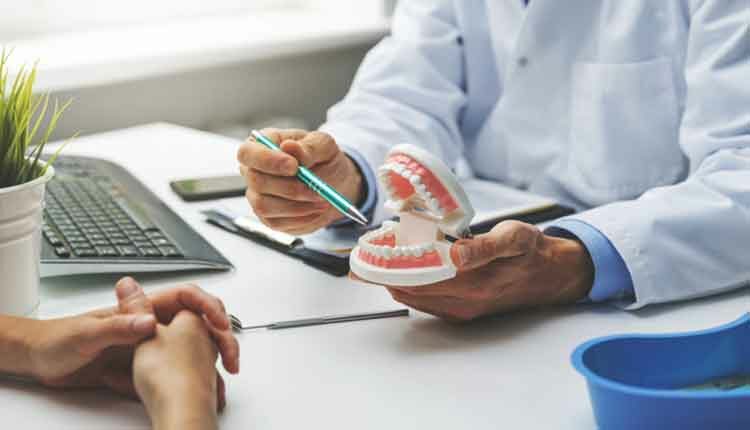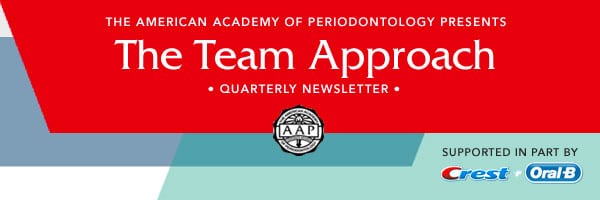 ronstik / iStock / Getty Images Plus
ronstik / iStock / Getty Images Plus
Talking to Your Patients About Whole Body Health
Dental, oral, and craniofaciacial (DOC) tissues are integrated with the entire body. Many body functions are executed within and around the DOC organs, such as mastication, digestion, respiration, speech, facial recognition, taste, and others. Similar to major organs, such as the liver, heart, brain, and pancreas, failure of the DOC tissues can lead to life-threatening conditions. As part of the digestive-immune-metabolic system, the oral mucosal compartment is unique due to its high vasculature, innervation, and permeability. Immune cells and sometimes microbes travel through significant vessels, such as the maxillary, facial, submental, and lingual vessels, to provide mucosal blood supply, making the gingival tissues highly accessible to immune cells. Locally, the surrounding tooth structure and periodontal tissues (gingiva, periodontal ligament, bone, and connective tissues) are essential to dental physiology and function.1 Besides biomechanical and tissue structural failures, there are two main lines of evidence indicating causes for diseases in the periodontal tissue and elsewhere:
- The oral cavity serves as a reservoir for microbes that can act as pathogens, impacting the tissues locally and systemically.
- Excessive inflammation from the local tissues can increase levels systemically and vice-versa.
In both direct or indirect pathways, inflammatory signals link cellular and molecular communications from most areas in the human body. These findings are supported by evidence-based research.2–5 Three subtopics have been further outlined and explored to expand communication in clinical practices and facilitate understanding of science and foundational knowledge in host-microbial interactions.
Importance of Inflammation as a Link Between the Mouth and Body
The field of inflammation has been rapidly expanding its horizons to include all medical fields,6 including dental and periodontal medicine. Acute inflammation is part of the body’s natural healing process. Cellular and molecular sensors first detect the invader or the damage, including multiple pattern recognition receptors for the induction of a safe, effective, and potentially heterologous mucosal protection. The cells (within the tissues and fluids) are equipped with a sensing system that can recognize what is outside and inside each cell — whether physical, biochemical, viral, or bacterial. These conserved sensing systems allow for broad recognition. Specialized systems are able to sense specific regions of the molecules and transfer this information further.7
The host is equipped with a vast number of immune tools able to sense and respond to danger signals. The primary sensors for the inflammatory response are innate immune cells that migrate to the injured site and resident stromal cells. Together, they trigger the production of mediators that modulate the fate of inflammation. Immune cells — such as neutrophils, macrophages, dendritic cells, and mast cells —produce low–molecular weight proteins called cytokines that control the initiation of inflammation, maintenance and regulation of its amplitude, and duration of the response. This leads to the transcription of cytokine genes, their translation, and secretion of proinflammatory cytokines from various cells. This is generally dependent on activation of a master intracellular gene, including transcription by nuclear factor κB (NFκB) nuclear protein. The NFκB-regulated pathways are activated by pattern-recognition receptors, such as toll-like receptors, that bind bacterial lipopolysaccharide and other important microbial related molecules.8
After sensors recognize information, a set of molecules is responsible for communication. These communicators are molecules bound or released in the milieu, and able to provide signaling response to other cells and tissues to enhance a biological function. Both inflammatory cytokines and chemoattractant cytokines, or chemokines, are produced for autocrine, endocrine, and paracrine functions. The cytokines are low–molecular weight proteins that modulate inflammation positively or negatively. Cytokines are produced by resident cells — such as epithelial cells and fibroblasts — and phagocytes in the acute phase. For example, a protein often classified as a cytokine is interleukin (IL)-1,9 one of many molecules able to provide communication among cells. It activates cells to produce more cytokines and is considered a pro-inflammatory molecule. There are nine known genes in the IL-1 family, and distinct genetic patterns have been previously associated with unique inflammatory profiles in several complex diseases,10 including periodontitis, cardiovascular disease, rheumatoid arthritis, and osteoporosis. Signaling molecules execute proinflammatory functions and anti-inflammatory functions.
Then, recipient tissues respond to the gradients of molecules presented, and it is modulated by spatial and time contribution of infectious agents. In fact, an excessive amount of a cytokine with chemoattractant functions, called IL-8, leads to migration of cells, including neutrophils, to the gingival sulcus and periodontal pocket, forming a neutrophil zone to protect against invaders. In addition, a granuloma formation can occur in the long-term, which is frequently associated with chronic periodontal and periapical lesions. Several tissues react to these molecular cues, including vasculitis and bone degradation. Matrix metalloproteinases, for example, are enzymes that will further degrade connective tissue and promote bone resorption.11
Finally, in contrast to acute inflammation, chronic inflammation is detrimental to local tissues promoting damage such as necrosis, fibrosis, and formation of granuloma. Through complex inflammation crosstalk and in the context of the whole body, oral inflammation can significantly influence systemic events. Since the central role of inflammation in this bidirectional oral-systemic reciprocal relationship has emerged, these concepts need to be clearly emphasized to patients.
Insights on the Oral Microbiome in Health and Disease
The term microbiome describes the collection of microbes and its genetic material within a site in the human body. Culture-based approaches were common in the first half of the 20th century to map microbiota and find key pathogens associated with oral diseases. For example, an important periodontal pathogen, such as Porphyromonas gingivalis, was the first oral microbe to have its genome completely sequenced.12 Through an evolution of sequencing technologies from Sanger shotgun to Illumina sequencing, identification of oral microbial genomes have become more common, and their diversity levels were included in the pivotal study that attempts to map the entire human microbiome.13 Thus, understanding that an ecological community of bacteria (primarily commensals) resides in the DOC tissues 14 is important for clinical practice and communication purposes. Today, the Human Oral Microbiome Database (available at: http://www.homd.org/) is the most comprehensive repository of microbial species that inhabit both the oral and nasal cavities. Out of the 775 microbial species included, 57% are officially named, while 30% uncultivated and 13% cultivated remain unknown.
Several groups of bacteria belonging to the genera are shared between intraoral sites, including Streptococcus, Gemella, Granulicatella, Neisseria, Prevotella, and Veillonella. However, some of the microbes are site-specific, showing unique niche adaptations.15 It is essential to note the microbiome interacts with the host cells and provides signals that favor health or promote dysbiosis (a driving force that promotes disease). Dysbiosis of the microbiome is more likely to present among chronic conditions in the oral microbiome, such as periodontal diseases.3
Providing Evidence-Based Research for Periodontal Treatment
Failure to remove the triggers, including pathogenic bacteria and inflammatory cells, leads to the formation of a chronic lesion, resulting in tissue resorption, or fibrosis and loss of function. The rapid and complete elimination of immune cells from a lesion is the ideal outcome following an inflammatory event. Regarding the microbiome, the presence of bacterial plaque and gingivitis is prevalent in humans, affecting more than 90% of the adult dentate population.16 The same direct correlation cannot be said for periodontitis; despite abundant plaque deposits in most people, the prevalence of moderate periodontitis (attachment loss greater than 5 mm) is around 40% of the population.17 Thus, while oral hygiene and primary therapy have a molecular and cellular impact within the periodontal tissues, clinicians deal with controlling complex host-microbial interactions.
Type 2 diabetes is a significant public health problem. Periodontal therapy has shown uniform outcomes across studies among patients with diabetes.18 The standard treatment goal of periodontal therapy for diabetes is to reduce HbA1c levels19 because reductions in HbA1c have shown to delay diabetic complications. Periodontal treatment may improve HbA1c levels by 0.4% to 0.5%;20 this systemic beneficial action of periodontal therapy demonstrates the importance of controlling local inflammatory conditions as part of diabetes management. Similar positive findings have been detected in studies of cardiovascular diseases, premature labor, and cancer, thus, demonstrating the beneficial impact of controlling oral inflammation.
Overall, a more precise molecular picture of the systemic impact of DOC tissues continues to evolve, emphasizing the importance of host-immune responses and the role of the microbiome within the local and systemic compartments.
References
- Newman MG, Takei H, Klokkevold PR. Carranza’s Clinical Periodontology. Philadelphia: Elsevier Health; 2009.
- Glick M. The Oral-Systemic Health Connection: A Guide to Patient Care. Batavia, Illinois: Quintessence Publishing Co Inc; 2019.
- Freire M, Nelson KE, Edlund A. The oral host-microbial interactome: an ecological chronometer of health? Trends Microbiol. 2021;29:551–561.
- Friedewald VE, Kornman KS, Beck JD, et al. The American Journal of Cardiology and Journal of Periodontology editors’ consensus: periodontitis and atherosclerotic cardiovascular disease. Am J Cardiol. 2009;104:59–68.
- Oral health in America: a report of the Surgeon General. J Calif Dent Assoc. 2000;28(9):685–695. PMID: 11324049
- Genco RJ. Clinical innovations in managing inflammation and periodontal diseases: the workshop on inflammation and periodontal diseases. J Periodontol. 2008;79(8 Suppl):1609–1611.
- Freire MO, Van Dyke TE. Natural resolution of inflammation. Periodontol 2000. 2013;63:149–164.
- Bauernfeind F, Hornung V. Of inflammasomes and pathogens—sensing of microbes by the inflammasome. EMBO Mol Med. 2013;5:814–826.
- Graves DT, Cochran D. The contribution of interleukin-1 and tumor necrosis factor to periodontal tissue destruction. J Periodontol. 2003;74:391–401.
- Marchesan JT. Inflammasomes as contributors to periodontal disease. J Periodontol. 2020;91(Suppl 1):S6–S11.
- Hardy DC, Ross JH, Schuyler CA, Leite RS, Slate EH, Huang Y. Matrix metalloproteinase-8 expression in periodontal tissues surgically removed from diabetic and non-diabetic patients with periodontal disease. J Clin Periodontol. 2012;39:249–255.
- Nelson KE, Fleischmann RD, DeBoy RT, et al. Complete genome sequence of the oral pathogenic bacterium porphyromonas gingivalis strain W83. J Bacteriol. 2003;185:5591–5601.
- Human Microbiome Project Consortium. A framework for human microbiome research. Nature. 2012;486:215–221.
- Teles F, Wang Y, Hajishengallis G, Hasturk H, Marchesan JT. Impact of systemic factors in shaping the periodontal microbiome. Periodontol 2000. 2021;85:126–160.
- Segata N, Waldron L, Ballarini A, Narasimhan V, Jousson O, Huttenhower C. Metagenomic microbial community profiling using unique clade-specific marker genes. Nat Methods. 2012;9:811–814.
- Eke PI, Dye BA, Wei L, et al. Prevalence of periodontitis in adults in the United States: 2009 and 2010. J Dent Res. 2012;91:914–920.
- Eke PI, Thornton-Evans GO, Wei L, Borgnakke WS, Dye BA, Genco RJ. Periodontitis in US Adults: National Health and Nutrition Examination Survey 2009-2014. J Am Dent Assoc. 2018;149:576–588.
- Iacopino AM. Periodontitis and diabetes interrelationships: role of inflammation. Ann Periodontol. 2001;6:125–137.
- Miller LS, Manwell MA, Newbold D, et al. The relationship between reduction in periodontal inflammation and diabetes control: a report of 9 cases. J Periodontol. 1992;63:843–848.
- Kocher T, Holtfreter B, Petersmann A, et al. Effect of periodontal treatment on HbA1c among patients with prediabetes. J Dent Res. 2019;98:171–179.



